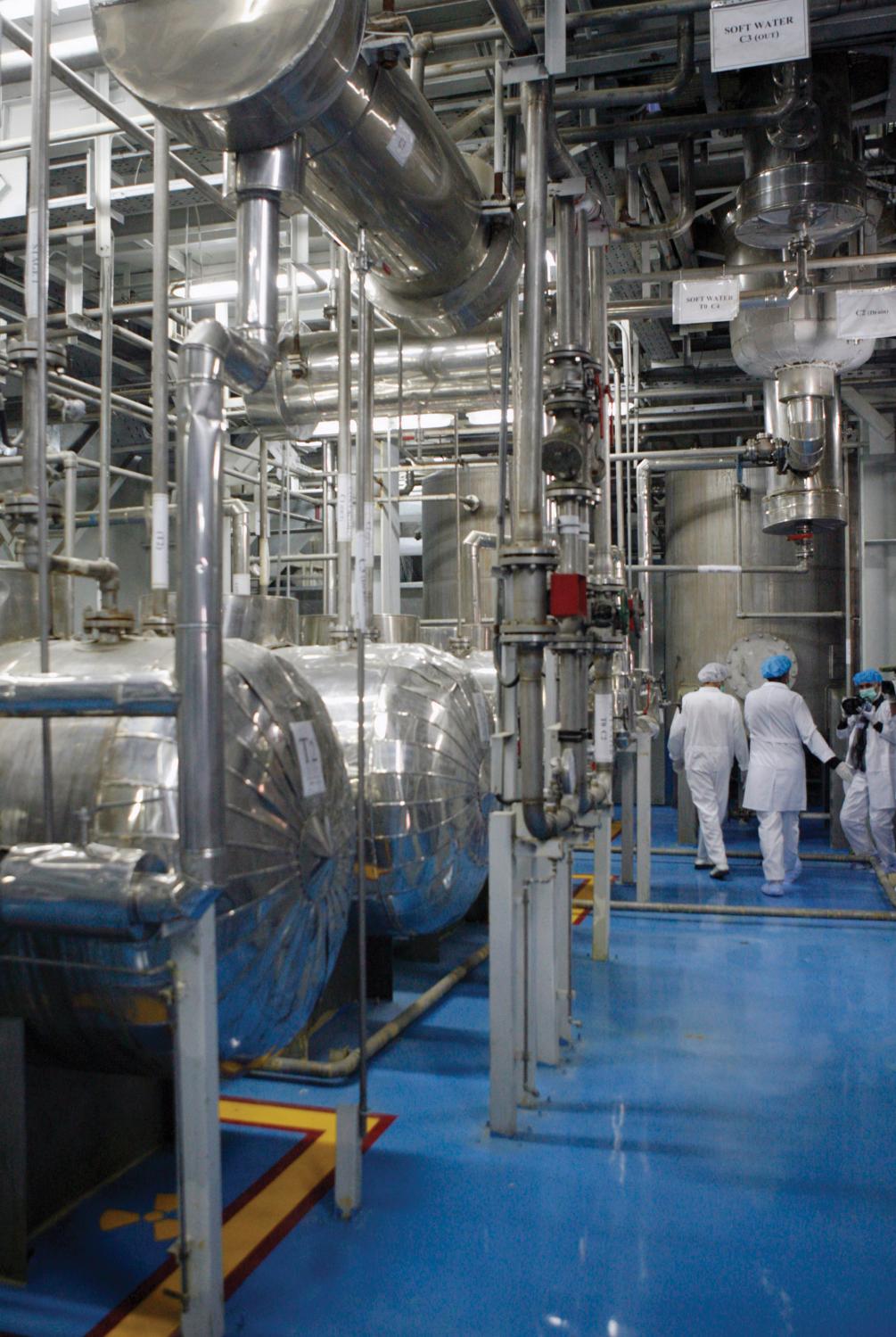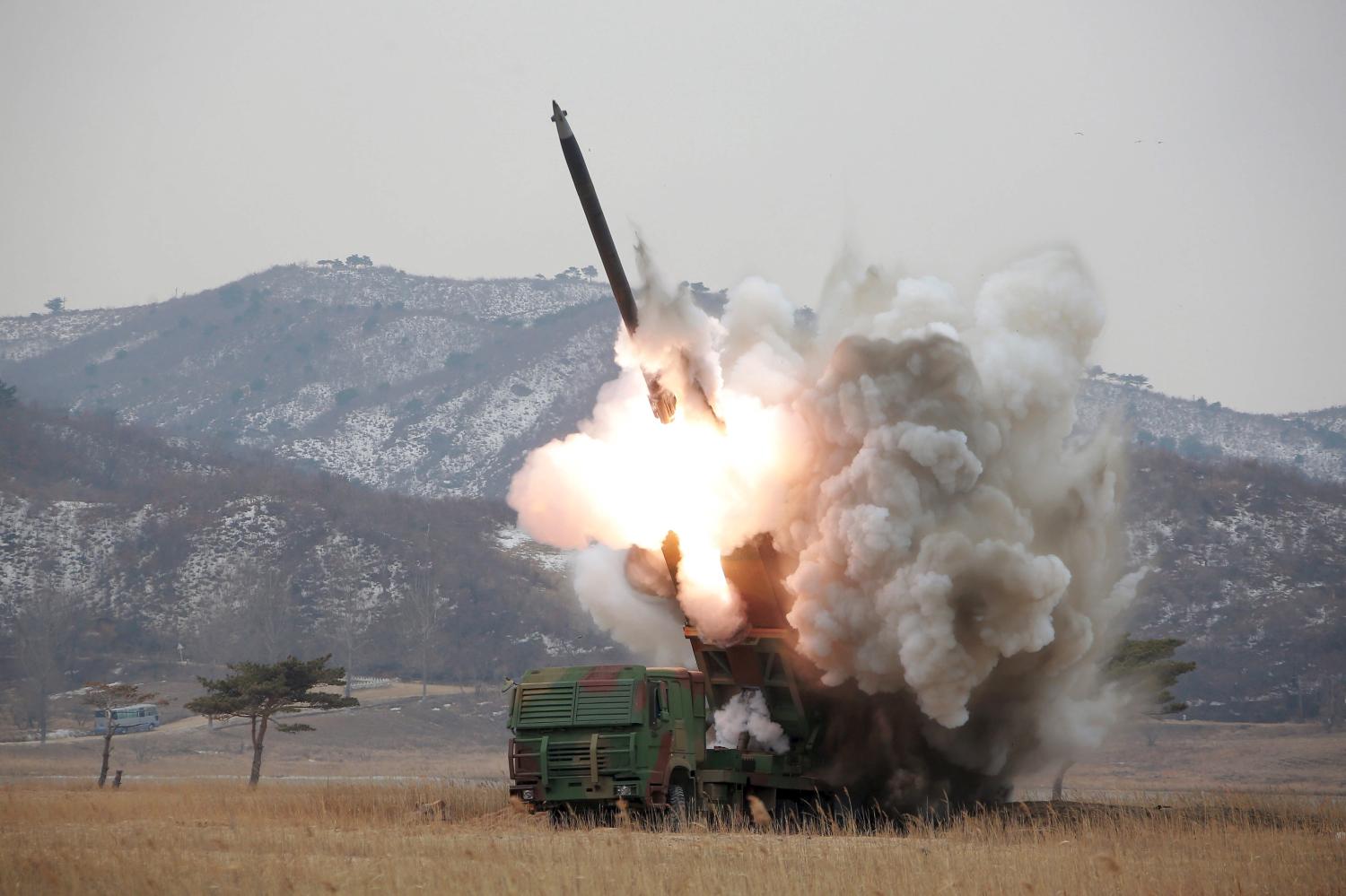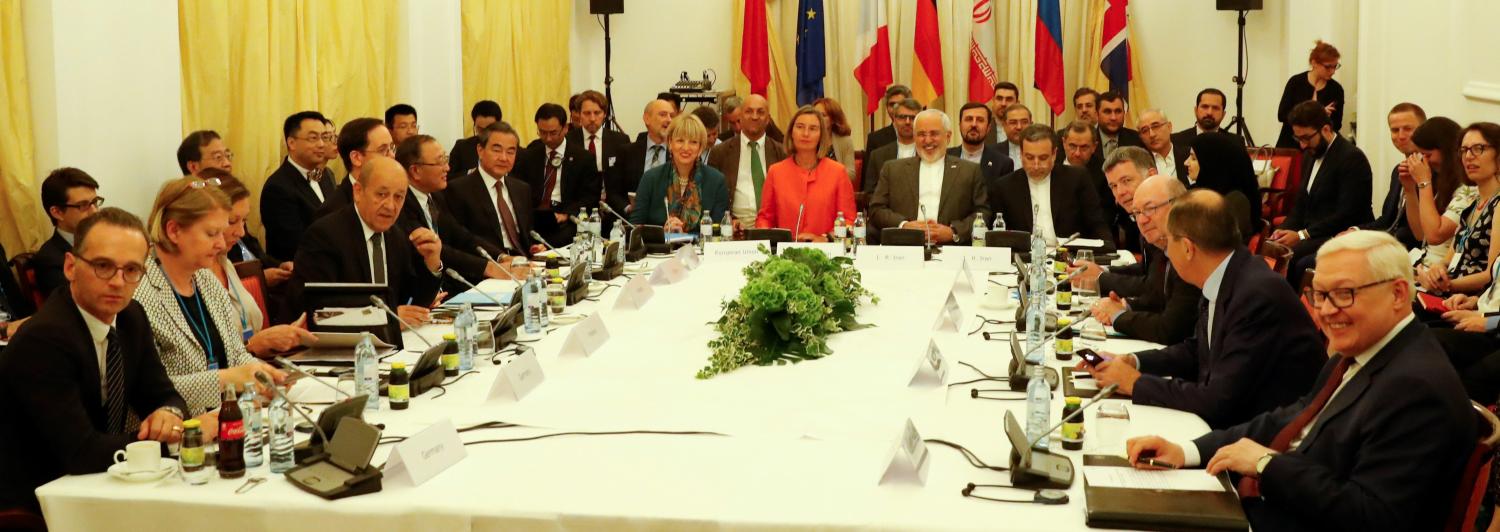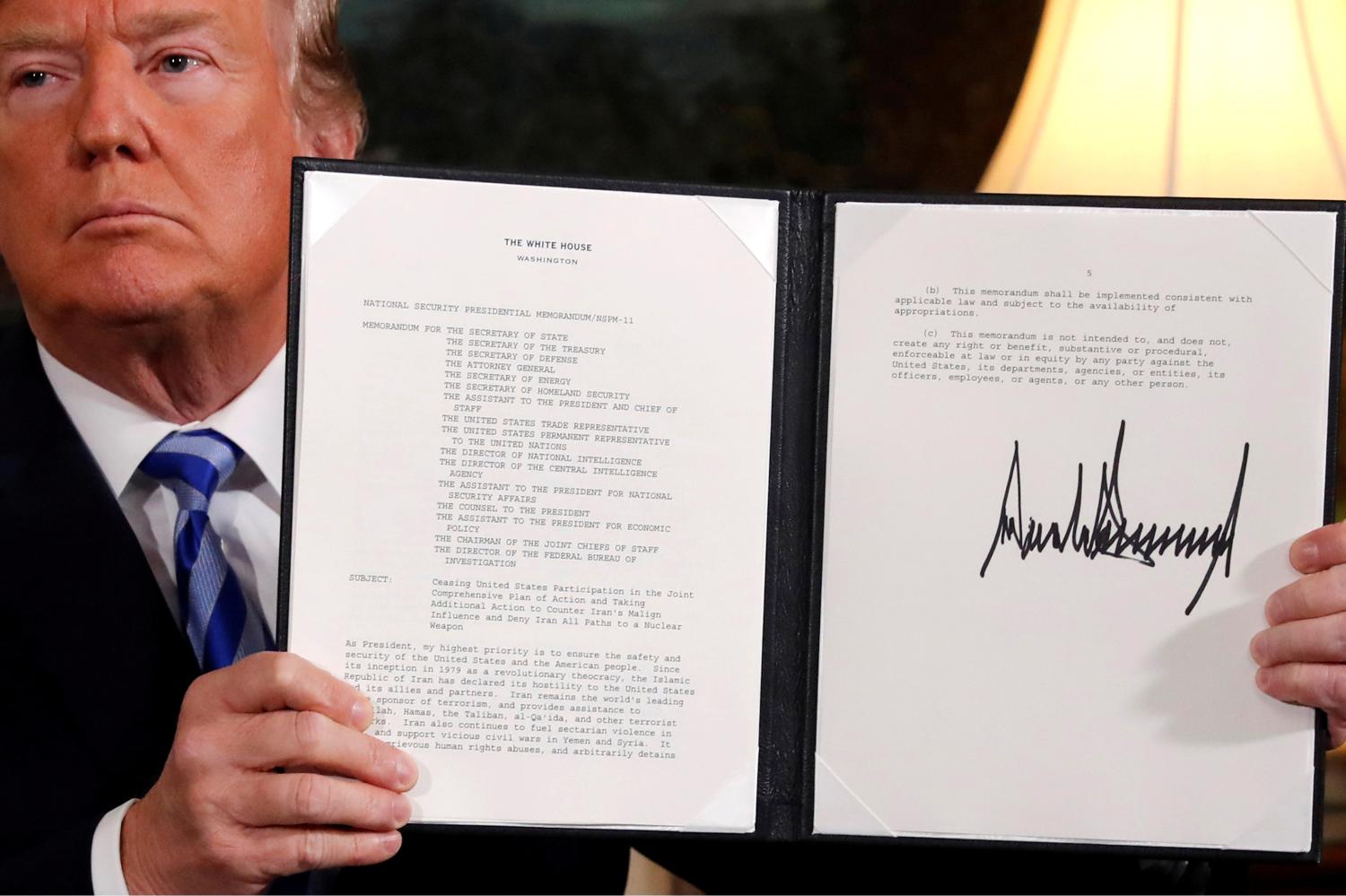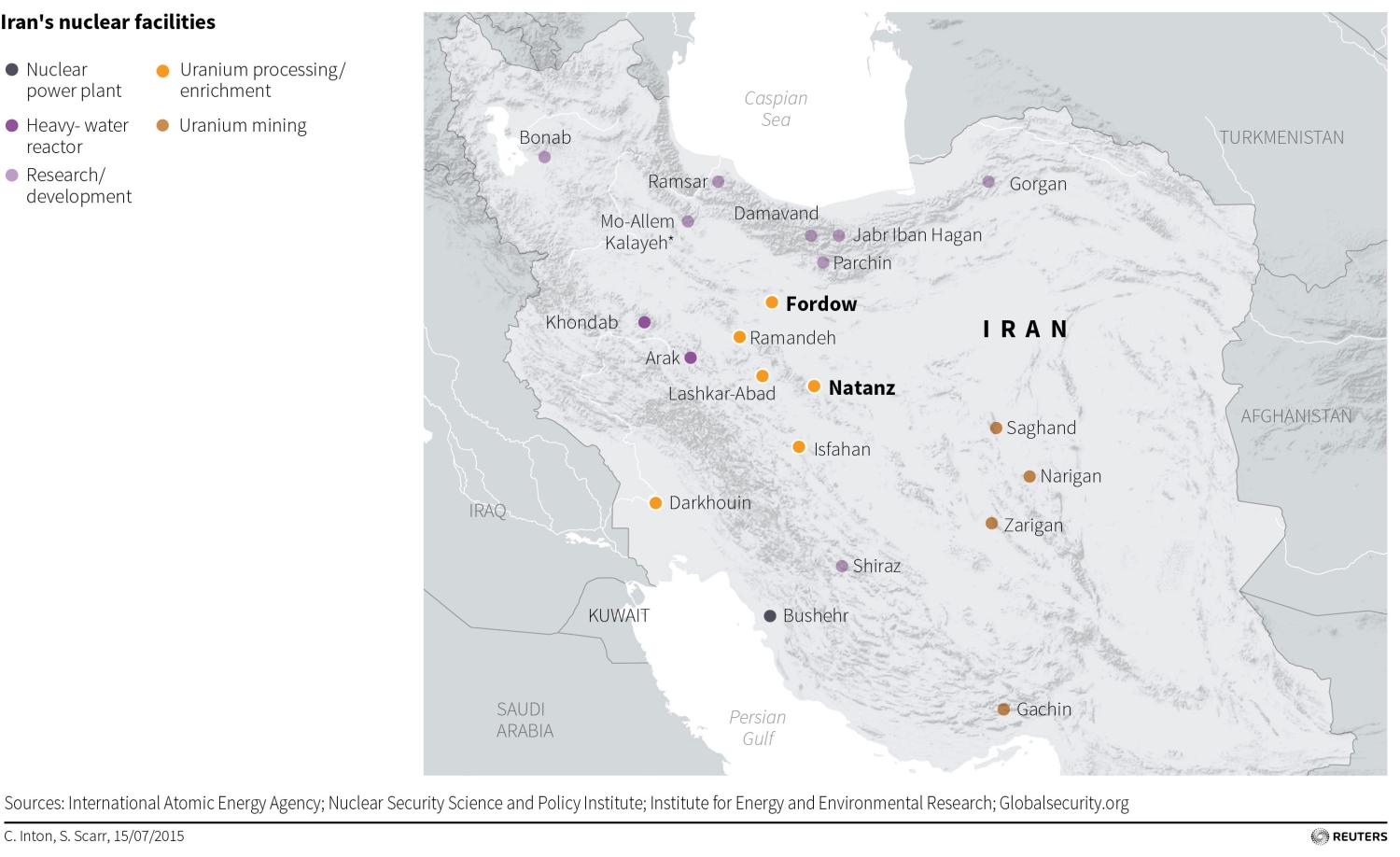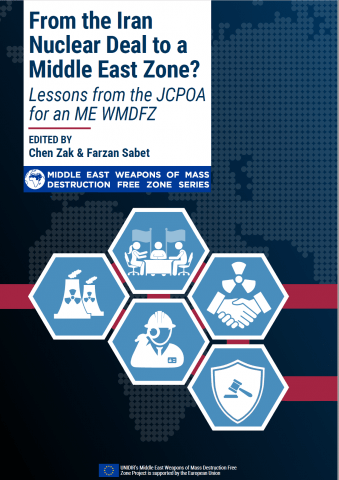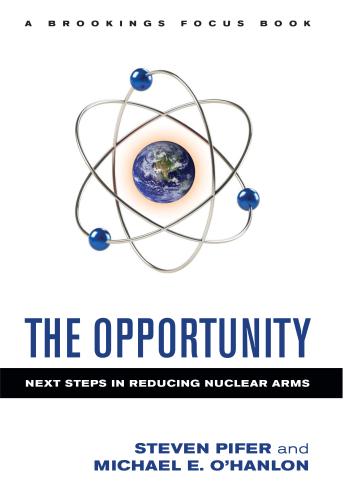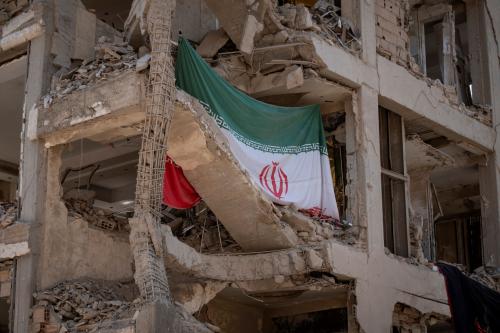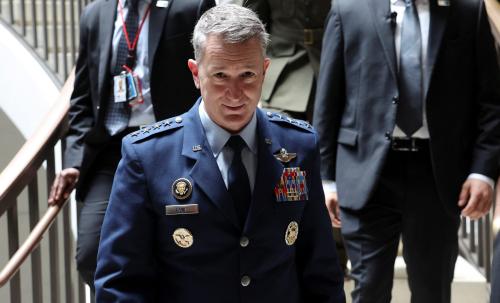This is the introduction and executive summary of a new Brookings report—to be released on March 28—on pursuing constraints on Iran’s future nuclear program.
The United States needs a new strategy for effectively constraining Iran’s future nuclear capabilities. The Trump administration’s current approach has little chance of succeeding. But simply returning the United States to the Joint Comprehensive Plan of Action (JCPOA) is not a long-term solution. By the time the United States would return to the 2015 deal, key nuclear restrictions would soon expire. Moreover, achieving the wide domestic support needed to make a nuclear deal with Iran politically sustainable in the United States would not be served by simply turning the clock back to before Trump took office.
The United States needs to pursue a renewed nuclear bargain with Iran, building on the solid foundation of the original and addressing its shortcomings. Diplomacy must play a central role in that effort, which will require:
- Mending fences with the Europeans and other key negotiating partners to rebuild the broad international support needed to press Iran to come to the negotiating table and accept meaningful restraints;
- Abandoning the current administration’s excessive demands in favor of a more realistic negotiating position that keeps Iran a safe and verifiable distance from the nuclear weapons threshold for an extended period of time, while demonstrating to Iran a willingness to accept an outcome compatible with Tehran’s legitimate interests;
- Pursuing a new deal focused on the nuclear issue, while actively and effectively— although separately and in parallel—implementing a broad strategy for addressing the other dimensions of the Iranian challenge, including its aggressive regional activities and its missile program;
- Improving the incentives (primarily sanctions relief) that would be offered to Iran, both in terms of their scope and their reliability to deliver anticipated benefits, in order to persuade Iran to accept a renewed bargain that goes beyond the JCPOA in important respects, especially in terms of the duration of its nuclear restrictions; and
- Making every effort to gain wide domestic support in the United States for any new negotiated outcome in order to make it durable and politically sustainable, despite presidential leadership transitions in Washington.
While diplomacy should take center stage in efforts to constrain Iran’s future nuclear capabilities, diplomacy alone is not enough. The Trump administration’s anti-Iran campaign has put great pressure on Tehran, but it has also reinforced Iranian opposition to U.S. demands and resistance to even engaging with the United States. To promote productive negotiations—and in the event that negotiations fail—diplomacy will have to be complemented by other policy tools that do not require Iran’s participation or consent, such as sanctions, counterproliferation measures, and deterrence. These more coercive policy tools can impede and discourage Iran’s movement toward the nuclear weapons threshold and provide incentives for Iran to negotiate seriously. But in the end, nuclear restraint must be Iran’s choice and is best codified in a renewed nuclear agreement.
The current impasse
Preventing Iran from acquiring nuclear weapons has been a bipartisan U.S. national security priority for over three decades. The JCPOA, concluded by the Obama administration in 2015, was a major step toward that objective, effectively blocking Iran’s pathways to nuclear weapons in the near and medium terms, and providing a promising platform for achieving a permanent solution in the future. But the Trump administration opposed the JCPOA, claiming both that the deal itself was flawed and that it failed to address other objectionable aspects of Iranian behavior, including its missile program and destabilizing regional activities.
Determined to fulfill a campaign promise, President Trump decided in May 2018 to withdraw from the JCPOA and re-impose sanctions against Iran that were suspended under the agreement. His administration hoped that its “maximum pressure campaign” would compel Tehran to accept a comprehensive new deal containing not just more rigorous nuclear restrictions than in the JCPOA, but also a resolution to a wide range of U.S. concerns about Iran’s activities, including its support for regional proxies, its activities in Syria, and its missile program. The administration’s demands were set forth in a highly ambitious list of 12 “requirements” outlined by Secretary of State Mike Pompeo soon after U.S. withdrawal. The combination of U.S. demands that the Iranian leadership was certain to reject, together with positions taken by senior administration officials both before and after assuming office, has persuaded many observers that the administration’s true goal is to promote the collapse of the Iranian regime.
Although it is too early to calculate the full impact of the U.S. pressure campaign, it is already clear that it is taking a heavy toll on the Iranian economy, magnifying deep-seated problems caused by many years of mismanagement and corruption. But despite the economic distress caused by the re-imposition of U.S. sanctions, the Trump administration is unlikely to achieve its goals, whether to force Iran to capitulate to its demands or to collapse the regime.
A significant impediment to the administration’s strategy is a lack of support, and often outright opposition, from countries whose cooperation would be needed to pressure Iran to come to the negotiating table and accept meaningful restrictions. Determined to preserve the JCPOA despite the U.S. departure, some Europeans have sought to circumvent U.S. sanctions in order to shield Iran from economic pressures that could lead it to leave the JCPOA as well. They recognize that their efforts, including the creation of INSTEX (the Instrument for Supporting Trade Exchange), a mechanism designed to facilitate trade with Iran without running afoul of U.S. sanctions, will have only a modest effect in reducing the impact of sanctions. It appears that their strategy is to buy time by persuading Iran to remain in compliance with the JCPOA for another couple of years in the hope that a successor U.S. administration will take office in early 2021 with a more positive attitude toward the agreement.
Reflecting their deteriorating bilateral relationships with the United States and their relatively close ties with Iran, Russia and China are more openly hostile to the U.S. anti-Iran campaign— and less concerned about Iran’s regional and missile activities—than the Europeans. Both have defended Iran in the U.N. Security Council, including on missile issues, and have pledged to maintain and even expand economic relations with Iran despite U.S. sanctions.
But the principal reason the administration’s strategy will fall short is Iran’s determination to resist U.S. demands and its resilience in the face of external and internal pressure. While acknowledging the harm the sanctions are doing, Iran’s leaders use the domestic hardships to mobilize public resistance to U.S. “bullying.” With decades of experience coping with sanctions, they have activated a strategy to mitigate their effects, including through smuggling operations (especially to get Iranian oil to market), diplomatic outreach to undermine international support for sanctions, and budgetary assistance to Iranians whose loyalty is deemed essential to regime stability. Iran’s leaders seem confident that their mitigation strategy—together with efforts by Europeans, Russians, Chinese, and others to maintain economic relations, as well as the implicit threat of repressive methods to stifle domestic dissent—will be enough to withstand U.S. pressure and maintain their grip on power.
Iranians say they will remain in the JCPOA as long as they receive the economic benefits to which they are entitled under the terms of the agreement. They are waiting to see how much revenue they can preserve from oil exports and how effective the Europeans and others will be in protecting Iran’s commercial links to the world. In the meantime, they seem to derive political value from isolating the United States from its traditional partners and from being seen by the international community as showing great restraint and responsibility in the face of extreme provocation by Washington.
The dispute between the United States and Iran is currently at an impasse. Despite mounting economic pressures, there are no signs that Iran will give in to U.S. demands. A U.S. strategy intended to force Iran to accept stricter nuclear limits and constrain its behavior in other ways has resulted in Tehran digging in its heels and made it more likely that Iran will rebuild its nuclear program in the near term than if the United States had remained party to the JCPOA.
The situation is not stable. A frustrated Trump administration could provoke Iran to leave the JCPOA in the hope that it would enable the United States to mobilize greater international support for confronting the regime. Or Iranian opponents of the JCPOA and the government of President Hassan Rouhani could finally prevail with their argument that continued nuclear restraint makes little sense in the face of U.S. efforts to strangle the Islamic Republic.
The United States needs a new strategy to effectively constrain Iran’s nuclear capabilities over the long term—one that employs a wide range of policy tools, including sanctions, counterproliferation measures, and deterrence, but gives a central role to diplomacy.
Sanctions as leverage for negotiations
While U.S. withdrawal from the JCPOA and re-imposition of sanctions were a serious setback in addressing the Iranian nuclear issue, sanctions pressure, if appropriately applied, can still play a significant role in achieving a new nuclear bargain. Depending on whether Iran remains in the JCPOA, the application and role of sanctions in U.S. strategy will change. But in all scenarios, the United States should make clear that the main purpose of sanctions is to provide leverage for negotiations and not to bring down the Iranian regime. And a modified approach toward implementing current sanctions—minimizing as much as possible the image of the United States standing alone, threatening its friends as much as Iran—could help build a more collaborative approach to addressing the various dimensions of the Iranian challenge.
As long as Iran remains in the JCPOA, the United States should look for ways to make reasonable exceptions to sanctions enforcement, such as the Trump administration’s exceptions for foreign companies working with Iran’s nuclear industry on JCPOA-approved projects or for oil importing countries allowing them temporarily to continue purchasing Iranian oil. It should also provide warnings to foreign governments when their companies are engaged in sanctionable activity and give them an opportunity to work with their companies to stop the activity before sanctions are imposed. And it should extend an olive branch to the Europeans by assuring foreign banks and companies that use INSTEX for humanitarian transactions that they will not be sanctioned, and by allowing U.S. companies to use that mechanism for such transactions as well.
If Iran decides to leave the JCPOA and rebuild its nuclear program, the United States should ramp up sanctions pressure to induce Tehran to halt its buildup and negotiate significant constraints. Acting alone or in conjunction with its European partners, Washington should invoke the “snap-back” provision of the JCPOA, which would restore all previous U.N. Security Council sanctions against Iran. While some countries friendly to Iran can be expected to resist strict enforcement of restored sanctions, snap-back would nonetheless significantly intensify pressures on Iran. The United States should also seek to diversify the scope of its own sanctions—targeting, for example, the light consumer goods industry—in order to signal to Iran that its coping mechanisms will have a hard time keeping up with evolving pressures.
Counterproliferation to impede sensitive Iranian imports
U.S.-led counterproliferation efforts—the use of national and multilateral export controls, interdiction of individual transfers, intelligence sharing, and other tools to prevent the acquisition of nuclear-related material, equipment, and technology—have impeded and slowed Iran’s pursuit of sensitive nuclear capabilities. But over the years, Iran’s illicit procurement network has managed to find weaknesses in those controls, and by now Tehran has indigenized key elements of its nuclear program. Still, to upgrade its nuclear capacities, Iran will continue to look to foreign suppliers, and it remains an important U.S. objective to ensure that Iran’s procurement serves only legitimate civil nuclear requirements consistent with its international commitments.
As long as Iran remains in the JCPOA, the United States should be prepared to widen exceptions to its sanctions against foreign entities for engaging with Iran’s nuclear industry—beyond existing exceptions covering the Arak reactor, the Fordow facility, and the Bushehr nuclear plant—to permit Iran to procure items in support of JCPOA-permitted nuclear activities, such as the replacement of broken parts. At the same time, a key U.S. counterproliferation objective should be to ensure that Iran uses the U.N. Security Council and JCPOA-mandated procurement channel for all permitted nuclear-related imports and does not pursue illicit nuclear-related imports outside the channel.
If Iran leaves the JCPOA and starts rebuilding its nuclear program, the United States, as recommended earlier, should support the snap-back of previous Security Council sanctions, which would bring back legally binding prohibitions on the transfer of most nuclear- and ballistic missile-related items to Iran. In these circumstances, the U.S. objective would be to impede Iran’s ability to enhance its nuclear capabilities quantitatively and qualitatively by seeking broad support for preventing Iran from acquiring materials and equipment from abroad. But unlike during the pre-JCPOA period, when a strong international consensus supported a near-total embargo on nuclear-related transfers to Iran, countries that regard Iran’s JCPOA withdrawal as justified could be reluctant to enforce the restored restrictions conscientiously.
Deterring movement down the path toward nuclear weapons
Using a variety of diplomatic, economic, and military tools, the United States and its partners can impede Iran’s nuclear program by explicitly or implicitly threatening Tehran with adverse consequences if it proceeds down the path toward nuclear weapons. They may seek to discourage three increasingly threatening stages of Iranian activity.
Deterring Iran’s departure from the JCPOA. Despite U.S. withdrawal, it is clearly in the U.S. interest for Iran continue abiding by the JCPOA. But having withdrawn, the Trump administration hardly has the standing to call on Iran to stick by the nuclear deal. That job falls largely to America’s P5+1 partners (China, France, Germany, Russia, and the U.K.). The Europeans have mainly sought to use positive incentives, hoping that INSTEX and other devices will convince the Iranians that remaining in the agreement will serve their economic interests. But the Europeans have also signaled to Iran that its withdrawal could trigger the snap-back of U.N. sanctions, making its economic situation considerably worse. They should reinforce that deterrent message.
Deterring a significant nuclear buildup. If, despite warnings, Iran decides to leave the JCPOA, the United States and other states should try to discourage a rapid or substantial increase in Iran’s nuclear capabilities. Threatening major adverse consequence for any increase beyond JCPOA limits is unlikely to be credible and effective as a deterrent. Instead, the United States should work with others, including the Europeans and even the Russians and Chinese, to identify particularly provocative Iranian actions—such as resuming enrichment at the Fordow facility, curtailing cooperation with the International Atomic Energy Agency (IAEA), enriching to 20 percent or greater, returning to the Arak reactor’s original design, or engaging in activities related to the development of nuclear weapons—and signal to Iran that such actions could trigger a strong international reaction.
Deterring breakout to the production of highly enriched uranium (HEU)/nuclear weapons. The most consequential action the United States and its partners would need to deter is Iran’s use of its nuclear infrastructure to produce HEU for the manufacture of nuclear weapons. While the United States should threaten severe economic sanctions in the event of such a breakout attempt—for example, a global secondary sanctions program targeting any transaction with Iran—the threat of dire economic consequences may not be enough to deter an Iran that has made a decision to go for nuclear weapons. Therefore, U.S. presidents should declare that the United States is prepared to use military force, if necessary, to stop Iran from producing nuclear weapons.
Diplomacy: Seeking a negotiated solution
Sanctions, counterproliferation measures, and deterrence can impede Iran’s efforts to enhance its nuclear capabilities and place pressures on it to restrain its nuclear program. But coercive tools alone cannot ensure that Iran will not acquire nuclear weapons. They must be complemented by efforts to achieve Iranian support for effective negotiated limits.
Since completion of the JCPOA, it has been widely recognized, including by the agreement’s supporters, that further negotiations would be needed to seek improvements in the deal, especially to ensure that key restrictions and monitoring measures do not lapse between 2023-35, as originally agreed under the deal’s various “sunset” provisions. Further negotiations are required whether or not Iran continues to abide by the JCPOA. If Iran sticks with the agreement, negotiations would need to get underway relatively soon to deal with these rapidly approaching sunsets. And if Iran leaves the JCPOA and begins ramping up its nuclear program long before key provisions are scheduled to expire, the need for negotiations would be more urgent—and the negotiating challenge of seeking to roll back a revived and growing program would be significantly greater.
Nuclear negotiations in the context of overall U.S. Iran policy. The Obama administration confined negotiations with Iran to the nuclear issue and pledged that it would counter other elements of Iranian behavior, including its regional activities and missile program, separately. The Trump administration has adopted a different approach. It says it favors a comprehensive new deal that would address the full range of U.S. concerns about Iranian behavior and that would meet its 12 highly demanding requirements.
Leaving aside the unrealistic and excessively demanding character of the administration’s 12 requirements, the approach of seeking a comprehensive agreement covering the full range of disparate U.S. concerns—and apparently linking a resolution of each of those concerns to the resolution of the others—is likely to prove unworkable and counterproductive. It would hold new nuclear restraints—a high national security priority— hostage to the resolution of other issues that may be less tractable, less resolvable in the same timeframe, or a lower national priority. Rather than address the nuclear issue in a mega-deal covering all of Iran’s provocative activities, the United States should pursue future nuclear restraints separately.
But to ensure adequate domestic support for a new nuclear deal and make it sustainable, any new diplomatic effort on the nuclear issue will have to be part of a broad and widely supported strategy that demonstrates that all problematic elements of Iranian behavior are being actively and effectively pursued—in parallel, but on different tracks.
Slim prospects for near-term negotiations. Although the Trump administration says a key purpose of its maximum pressure campaign is to bring Iran to the negotiating table, it seems in no rush to engage, perhaps waiting for the effects of the re-imposed sanctions to sink in and provide additional negotiating leverage. For their part, the Iranians, without closing the door to future negotiations under the right conditions, have ruled out talks on the nuclear issue for now. They resent being pressured to renegotiate a deal they believe already contains major Iranian concessions, especially with a U.S. government they regard as untrustworthy and dedicated to regime change.
U.S. objectives in future nuclear negotiations. The Trump administration’s demands on the nuclear issue, especially the requirement that Iran abandon its uranium enrichment program altogether, are not achievable. The United States does not have the leverage to compel such outcomes, and Washington would not have the support of any of its former P5+1 partners if it insists on them.
U.S. objectives in any future nuclear negotiations—whether the product of negotiations is an amended JCPOA, a supplement or follow-on to the JCPOA, or a new agreement— should be:
- To ensure a sufficiently long breakout time at declared enrichment facilities. This would require a combination of restrictions on enrichment capabilities and effective monitoring measures capable of providing confidence that any Iranian breakout attempt at declared facilities would be detected promptly and the international community would have plenty of time to block it before Iran could produce enough HEU for a nuclear weapon.
- To prevent undeclared activities and facilities. This would require broad IAEA monitoring measures to deter and detect any diversion of equipment and materials from declared civil nuclear activities to a covert program, measures to monitor Iranian nuclear-related imports, and effective and timely inspection arrangements capable of resolving concerns about activities at undeclared locations.
- To block the plutonium path to nuclear weapons. This would require agreement on a series of constraints on heavy water reactors, reprocessing, and spent reactor fuel.
- To ensure long-lasting restraints. This would require deferring or, in some cases, eliminating the JCPOA’s expiration dates.
Elements of a new nuclear deal. Whether or not Iran remains bound by the JCPOA, the following are some key outcomes the United States should seek in any future negotiations (a more complete set of desired outcomes is in Chapter VII):
- While the United States should pursue the longest possible breakout time at declared facilities, a period as short as six months should be adequate, provided other elements of the agreement increase the likelihood of timely intervention to thwart a breakout attempt (e.g., expeditious IAEA investigation timeframes).
- The United States can be flexible on the particular mix of restrictions on Iran’s enrichment program. Any given breakout time—whether six months, 12 months, or anything in between—can be achieved with differing combinations of restraints (e.g., on numbers and types of centrifuges, enrichment level, enriched uranium stocks).
- JCPOA restrictions on the plutonium path should be retained: A ban on reprocessing and the construction of heavy water reactors, the completion of Arak reactor conversion, and the shipment of all spent reactor fuel out of Iran.
- The JCPOA’s Section T commitment not to engage in activities associated with nuclear weapons development should be retained and the IAEA’s authority to verify Section T should be affirmed.
- The current procurement channel for monitoring and approving nuclear-related imports should be retained or, at a minimum, the IAEA and parties to the new agreement should receive advanced notification of all transfers to Iran of nuclear and dual-use items on the control lists of the Nuclear Suppliers Group (NSG).
- The JCPOA’s timelines should be accelerated for gaining IAEA access to suspect facilities in Iran, for escalating to the policy level cases of Iranian denial of access, for taking issues to the Security Council, and for seeking and obtaining a Security Council response.
- Enrichment-related restrictions should remain in place for at least 15 years from the time a new arrangement takes effect. Monitoring arrangements of limited duration should be extended for five years after the expiration of the enrichment restrictions. Bans on reprocessing- and heavy water-related activities and Iran’s adherence to the IAEA Additional Protocol should be permanent.
In evaluating possible negotiated outcomes, it will be important to think afresh about how various constraints contribute to the goal of preventing an Iranian nuclear breakout. In particular, given what most experts believe is the greater probability of Iran breaking out covertly, a higher priority should be given to boosting the capability to detect covert activities relative to the objective of maximizing breakout time at declared facilities, which received top (and perhaps inordinate) priority in negotiating the JCPOA.
The form and legal character of a new nuclear arrangement. To make JCPOA restraints more effective and durable, negotiations must alter the original JCPOA bargain. It is not an option for the United States to simply rejoin the JCPOA and ignore the impending sunsets. The altered bargain can take several forms, including an amended JCPOA, a JCPOA left unchanged but supplemented by additional or follow-on measures, or a new agreement. A U.S. administration can be flexible on this, adopting an approach that can be supported both in Iran and domestically in the United States.
Whatever form a new arrangement takes, a key decision will be whether it should be a non-binding political commitment like the JCPOA (i.e., a “plan of action”), or preferably, a legally binding agreement approved by Congress. If achievable, the latter option would make the agreement more sustainable domestically and perhaps give Iran greater confidence that a deal it makes with one U.S. administration will survive presidential transitions. A treaty ratified by two-thirds of the Senate would best promote the agreement’s longevity, but that threshold would be too high on an issue as contentious as Iran. A good alternative would be a congressional-executive agreement requiring approval by a simple majority vote by both houses of Congress.
Parties to an agreement. While bilateral engagement, especially between the United States and Iran, will be essential in negotiating a new arrangement, as it was in negotiating the JCPOA, the agreement should be multilateral to give it greater international credibility and legitimacy. The original parties to the JCPOA, given their expertise and intimate familiarity with the subject, could be participants in a new arrangement. U.S. regional partners should be fully and actively consulted in the course of negotiations.
Starting point for negotiations. An issue that any U.S. administration would need to address in approaching a revised nuclear arrangement is whether to re-enter the original JCPOA at the outset of negotiations or remain outside. An argument for remaining outside is that re-imposed sanctions would remain in place and provide additional negotiating leverage. In addition, rejoining the original deal, even for the purpose of negotiating a better one, could be criticized by JCPOA opponents. An argument for rejoining the deal at the outset of negotiations is that it may be necessary to get Iran and others to the negotiating table. In any event, the choice can be made when there is a real prospect of beginning negotiations, depending on conditions at the time.
Whether the United States re-enters or remains outside, it should regard the JCPOA text as the starting point for negotiations—whether it is amended, supplemented, or used as the basis of a new agreement. The extraordinarily detailed JCPOA and its annexes provide the clarity and specificity needed for effective implementation. Negotiators should not start from scratch, even as they seek new or modified provisions.
Offering incentives for Iranian nuclear restraint. The Iranians do not want a new or modified deal. They want to preserve the JCPOA, which contains all the concessions they want to make, and then rebuild their nuclear program when key restrictions expire. Growing sanctions pressure gives them strong incentives to reconsider this posture, but it will not enable the United States to dictate the terms of a new arrangement. If Washington wants stronger or longer-lasting restrictions than those contained in the JCPOA, it will need to offer incentives to Iran, mainly in the form of sanctions relief. At the same time, the United States will need to consider that the more sanctions relief it provides to get a nuclear deal, the less leverage it will have to promote Iranian restraint in other areas, including its missile program and regional activities.
A starting point in an incentives package would be the restoration of the JCPOA’s sanctions relief measures. But given Iran’s disillusionment with the sanctions relief provided under the JCPOA, it will be necessary to give Iranians confidence that sanctions relief will actually result in economic benefits. Such steps could involve providing clear guidance on sanctionable behavior so that foreign entities do not stay away out of excessive caution; assuring such entities that if they inadvertently engage with sanctioned Iranian entities, they would have sufficient time to unwind their engagement without fear of penalty; and agreeing that licenses approved for dealing with Iran (e.g., in the area of civil aviation) would only be revoked in the event of a material breach of their terms.
For the nuclear restrictions recommended above, the United States would have to go beyond sanctions relief offered in the JCPOA. In particular, the United States should consider partial relaxation of the primary U.S. embargo that, with a few exceptions (e.g., on food and medicines), prevents American individuals and entities from dealing with Iran. In particular, Washington should consider permitting Iranian access to consumer goods, allowing U.S. technical support for Iranian light industry, and permitting limited access for U.S. dollar clearing operations.
The road ahead
The Trump administration’s decision to withdraw from the JCPOA was a significant setback to the goal of constraining Iran’s future nuclear capabilities. Its re-imposition of far-reaching U.S. sanctions and unrealistic demands for a fundamental reorientation of Iranian behavior will not produce the comprehensive new deal it says it favors. Instead, its actions have stiffened Iranian resistance to U.S. demands and to negotiating with the United States, alienated potential partners needed to press Iran to accept meaningful restraints, given a boost to hardline elements in Tehran, and increased the likelihood that Iran’s leaders will decide to leave the JCPOA and rebuild their nuclear program much sooner than they would be allowed to do under the agreement.
Whether or not Tehran remains in the JCPOA, preventing Iran from achieving a large-scale uranium enrichment capability and reducing its breakout time to a matter of a few weeks will remain a critical national objective. But to overcome the current impasse between Washington and Tehran, the United States will need to make adjustments in its current approach, including by healing the rift with the Europeans and other potential partners, showing greater flexibility in enforcing U.S. sanctions, credibly disavowing a policy of regime change, and adopting realistic negotiating objectives that signal to Iran a willingness to accept an outcome compatible with its interests.
It would be best for the Trump administration to make such adjustments, both because the situation could deteriorate significantly in the next two years unless the impasse is overcome and because the Trump administration would be in a good position to command broad domestic support for a more promising Iran strategy. But the likelihood of the current administration making what it would see as fundamental changes in its position is probably very small. If that is the case, the responsibility for getting the Iran nuclear issue back on track would fall to a successor administration.
In the near term, therefore, prospects for productive negotiations on Iran’s nuclear program are slim. In these circumstances, policy tools for constraining Iran’s nuclear capabilities that do not rely on Iranian participation or consent—including sanctions, counterproliferation measures, and deterrence—should be pursued. But while implementing these policy tools and waiting for favorable conditions for negotiations to emerge, it is important for interested governments and outside experts to begin thinking about such questions as how to get negotiations underway, the contents of a new agreement, and how to obtain the necessary domestic and international support. The authors hope this report will contribute to that preparatory effort.
The Brookings Institution is committed to quality, independence, and impact.
We are supported by a diverse array of funders. In line with our values and policies, each Brookings publication represents the sole views of its author(s).


